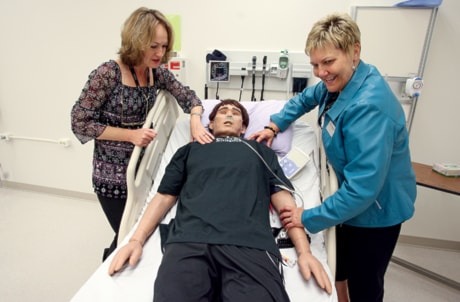The nursing program at Red Deer College has added two eerily human-like pieces of technology to help train new nurses.
The college now has two human patient simulators, which both look a bit like an electronic and rubber version of a quarterback in terms of size and build.
The $100,000 pieces of equipment are able to cry, sweat and drool. They blink, have a heartbeat and a pulse — but no names at the moment.
The simulators can go into cardiac arrest, have a severe allergic reaction and make life-like bowel sounds.
In the past, the RDC nursing program has had simulators, but they were more like human-sized rubber dolls. Instructors could walk students through a scenario, but until now the simulators didn’t react to what students were doing.
With the two new human patient simulators, students can start an intravenous line, put in a catheter and deal with the simulators having a seizure or experiencing laboured breathing.
Sheila McKay, chair of the nursing program, said the simulators won’t replace but will augment the clinical learning that the students do in hospitals and care centres.
She said sometimes during their clinical time students don’t experience every possible scenario, but having the simulators means that they could.
McKay said students working on a surgical unit in a hospital might not witness certain rare post-operative complications, but with the simulators every student can have a chance to see signs that could suggest something is going wrong.
In other cases, it might be a matter of setting up a stressful situation for students so they don’t see it for the first time in an emergency room — something like a cardiac arrest or other trauma.
“A lot of students find that extremely stressful,” said Kathy Regehr, lab co-ordinator with the nursing program at RDC.
“It’s hard to learn on the fly. It’s not something you want to learn on the fly. We want to create as much patient safety as we can. So we can actually simulate a situation like that and make it as real as possible.”
Afterwards, instructors can go over what went well and what didn’t.
The human patient simulators will also allow students to see how they react in various situations — whether stressful or gross — before dealing with a real patient. The lab instructors have recipes to create what looks and smells like real vomit, urine, stool, mucus, blood and infected wounds.
“Our goal is to simulate the real situation as much as possible. What we intend to do is build as many things into the scenario as possible so that students suspend their disbelief,” said Liz Sinclair, the simulation lab co-ordinator at RDC.
The room, where the simulators are housed is set up to look like a hospital ward, with white walls and floor and tools that simulate equipment to take blood pressure, temperature, and scopes for eyes and ears.
Nursing instructors will be trained on the simulators over the next year, with the high-tech equipment being fully implemented into RDC’s nursing program by September 2010.
McKay said in the end, RDC wants student nurses to learn as much as they can before they finish their studies. “That’s the final outcome. We want to graduate people who are able to provide safe, competent care,” McKay said.
sobrien@www.reddeeradvocate.com
